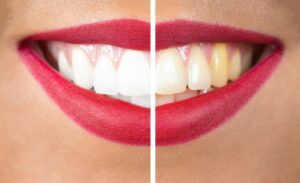Do you notice dark stains or yellowing in your teeth? Dental discoloration can make you want to hide your smile. But you can talk to your cosmetic dentist to find safe and effective ways to make your smile look brighter.
Professional teeth whitening treatment can lift stubborn tooth stains to the surface where they can easily wash away and leave your smile looking pearly white and beautiful. With supervision from your dentist, you can look forward to a stunning and natural-looking finish.
The type of cosmetic dental work that will work best for your smile may vary depending on the type of stains on your teeth. Your dentist can determine the cause of dental discoloration and offer treatment accordingly.
But you can read on to learn about three common reasons you might form stains on your teeth. Then you can better prevent them from developing in the first place.

Staining Agents in Certain Foods
You might develop stains on your teeth due to the foods and beverages you consume. Dark-colored items get their color from naturally occurring substances called tannins. Coffee, tea, and red wine all contain tannins. When you consume tannins, they transfer to your teeth and absorb into the enamel, leaving visible stains behind on the tooth’s surface.
A toothbrush cannot reach these stains within the enamel to scrub them away. While your dentist can help you get rid of them, you should pay attention to your smile’s appearance and make sure your diet does not affect your tooth color.
You can sip dark beverages through a straw or dilute your drink with milk or water to reduce the likelihood of forming dental discoloration. But these efforts will not eliminate the danger entirely. Limit or avoid these types of foods to preserve the look of your smile.
Untreated Dental Concerns
Some dental problems might cause stains to appear on your teeth as a side effect. For instance, cavities, early forms of tooth decay, can look like brown or white spots on the teeth, signifying areas where bacteria hurt the enamel.
A dentist can treat the cavity and provide you with a tooth-colored dental filling to restore the health and appearance of the tooth. But sometimes, tooth stains can remain even after a dentist treats the underlying problem. Talk to your dentist to find the right smile enhancement solution to address your dental discoloration.
Factors Outside of a Patient’s Control
Dental discoloration might develop for reasons beyond an individual’s control. For example, aging will cause the tooth enamel to weaken, which may make the teeth appear yellow or dull in color.
Certain medicines also include dental discoloration as a side effect. You cannot always stop taking a medication due to an impact in your smile’s appearance. Discuss preventative oral health care with your dentist to preserve your tooth color. Routine teeth cleanings and oral exams can keep your teeth strong enough to resist dental stains.
